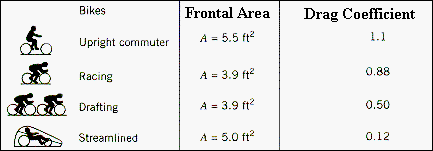| |
The effect
of geometry on the drag coefficient of some bicycles is shown below. The
upright position frequently used when riding a commuter bike gives a frontal
area of 0.5 m2 and a drag coefficient of 1.1, close to that for
a flat plate! By crouching the frontal area of the bike-rider system is reduced
to 0.36 m2 and the drag coefficient also decreases to 0.88 due
to the improved "streamlining" of this position. When two cyclists
ride in a drafting configuration they behave rather like a single, longer
streamline body. The frontal area remains at 0.36 m2, but the drag
coefficient drops to 0.50 giving a 43% reduction in the drag force. The final
streamlined configuration has a frontal area of 0.46 m2 but an
even lower drag coefficient of 0.12. Prone, streamlined bikes hold world speed
records due to this drag reduction advantage. Don't forget that cooling
of the human becomes a problem with this design unless air is ducted to the
rider. The needed ducts and air exhaust will increase the drag of the bike. |
|

